How often do we hear the following? “I don’t have time to _____.” “I can’t take the time to _____.” “If I do this, I won’t have time to _____.” “I can’t believe they don’t understand _____.” “It’s like they’ve never seen or heard _____.”
Time and meaning?
Time and meaning. How often do we hear the following? “I don’t have time to spend 3 days on this section.” “I can’t take the time to do a project.” “If I do this, I won’t have time to teach them everything they have to learn.” “I can’t believe they don’t understand _____.” “It’s like they’ve never seen or heard _____.”
Time and meaning…
How often do we hear the following? “I don’t have time to spend 3 days on exponential growth (slope, poetry, reconstruction).” “I can’t take the time to do a project.” “If I do this, I won’t have time to teach them everything they have to learn.” “I can’t believe they don’t understand exponential growth (slope, poetry, reconstruction).” “It’s like they’ve never seen or heard of exponential growth (slope, poetry, reconstruction).”
Time and meaning!!!
We want our learners to be efficient. We teach shortcuts, right? I’ve been wondering about shortcuts for a while. Is it a shortcut if I don’t know the long way? We teach King Henry Died Monday Drinking Chocolate Milk to help learners become efficient about the order of prefixes in the metric system. We teach Please Excuse My Dear Aunt Sally to help learners remember the order of operations.
Now, don’t get me wrong. I LOVE mnemonic devices! In How the Brain Learns Mathematics, How the Gifted Brain Learns, and How the Special-Needs brain learns Dr. Sousa gives evidence that process mnemonic devices are powerful for learners, particularly those with dyscalculia.
“Process mnemonics are so effective with students who have trouble with mathematics difficulties because they are powerful memory devices that actively engage the brain in processes fundamental to learning and memory. They incorporate meaning through metaphors that are relevant to today’s students, they are attention-getting and motivating, and they use visualization techniques that help student link concrete associations with abstract symbols.”
How the Brain Learns Mathematics, David Sousa
How am I, how are we, helping students link concrete associations with abstract symbols?
Our current learning target in Algebra I involves exponential functions – exponential growth and decay. We can just teach them the formula, but are we really teaching them if we do that? Haven’t they been given the formula before? How do we link concrete meaning to the abstract symbols in the formula?
My teammate, @bcgymdad, taught me how to do this a couple of years ago. It takes more time to teach it – several days. I’d like to describe it to you; you can decide about time and meaning and efficiency. I’d LOVE to know what you think! Oh, and sorry for the pseudo-context. We had a sense of play; we had fun, and we learned.
Question 1:
I need to hire two of you. You can pick up some quick spending money. Volunteers? Great! The job is to clean windows for 20 days. DG, I want to hire you and I’ll pay you $40 per day; does that sound fair? <Yes, ma’am> GW, I also want to hire you, but your payment plan is different, okay? I will pay you $0.01 today, tomorrow $0.02, $0.04 the next day, and so on. Not a new problem to me, but apparently a new problem for the learners. I took a quick poll of the class. Whose payment plan would be best for your if you intend to complete all 20 days? The vote was great; it split right down the middle.
Big questions: If both workers complete the 20 days, how much will they each be paid? Instantly, everyone knew DG would be paid $800. <Yeah, baby!> How much would GW be paid? They just sat there. Really! Waiting for me to tell them; they are so conditioned that even after 4+ months with me, they waited. I had to say “Don’t you have a calculator? Figure it out?” Then my favorite question “is it okay if we work together?” AHHRRRGGGG!!!!!!! Are you kidding me? YES!
Not one learner, not one, thought to use a spreadsheet. Never occurred to them; they didn’t know how. We stopped; we took the time to learn.
Stage 1: Simple spreadsheet formulas – make the spreadsheet work and why to use a spreadsheet.
 |
 |
DG is feeling “ripped-off”. So let’s change his daily rate to $100. BOOM! The power of spreadsheets.
 |
The question…will the time taken to do this work numerically connect meaning to the abstract symbols? The first meaningful connection popped up immediately. Again the question…How much was GW paid for her 20 days of window washing?
My learners who speak before they think belted out “$5242.88!” KC, profoundly quiet reserved KC, said loudly with a great frustrated voice: “No she did not! That’s how much she was paid on day 20!” Meaning! This led them to ask me how to find the total. I love it, love, love, love it when they ask me to teach them something.
 |
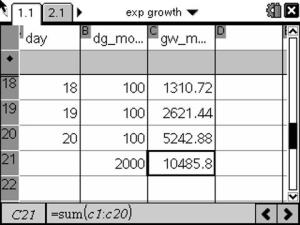 |
We graphed the data. Look how much can be learned graphically. Now we can visualize the difference in constant rate and exponential rate. Then we wrote equations. It made sense to them that the equation for GW was y = 0.01(2)^x. Interestingly, they had a little trouble getting to DG’s equation y = 40. Sigh…so much work to do to connect ideas.
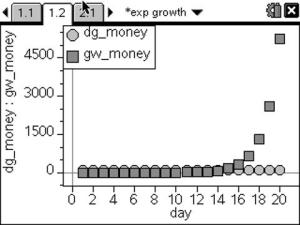 |
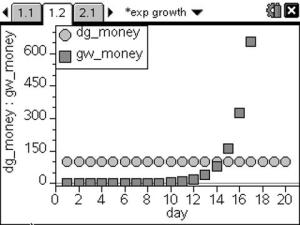 |
While my learners could not solve for the day DG and GW would be paid the same wage algebraically, they can all tell me when looking at the graph. Are we letting the analytic algebra, the efficient way, hamper learning and understanding?
Question 2:
ES has $1500 and invests it at 8.5% interest compounded yearly. In 10 years, he will be 24 and, hopefully, graduating with his masters degree. How much money will he have at the end of 10 years if he just makes this initial deposit?
Can you apply what we just did with spreadsheets to answer this question? Oh, if you know the formula, just use it. It is more efficient. Does anyone know the formula? Nope. They know there is a formula, but they don’t know it. And that is OK.
Without direct instruction from the adult in the room, one learner realized that you had to have a year zero. This rumor then spread throughout the community very quickly. Oh sure, there were questions about getting the spreadsheet to work, but they were confident about their math/arithmetic. Well, oops, some had to remember that 8.5% is not 8.5; it is 0.085. But they learned it experientially and from each other; they were not told. They learned from the data; it did not make sense.
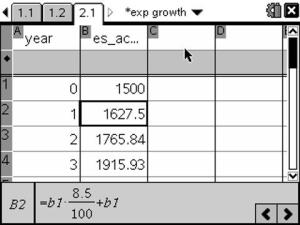 |
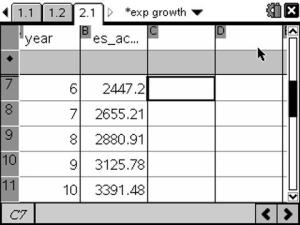 |
Again, the power of the spreadsheet. 8.5% is not at all realistic for 2011. What happens if we change the interest rate to 1.5%?
 |
 |
How long will it take ES’s money to double? The spreadsheet is not efficient. Using a graph is much more efficient. This is why we need to understand the formula, but not before we understand the problem.
 |
 |
Do you think the spreadsheet work will help learners understand? Does taking the time to work with the numbers help students understand the problem? Will it help students interpret the graph?
Time and meaning…If we take the time to teach multiple representations of the same idea will we increase the opportunities for students to find meaning and understanding?
Jill,
I really like this post. I also agree with you that mnemonics have a role in mathematics as well, but I think too often, they are just another brick in the impenetrable wall of procedures that many students see math as. After all—when do they ever get to make up the procedures or the mnemonics?
I would love to see math (and science) classes focus more on teaching the why of the mnemonic. I think a great question for an 8th grader is: “Show me why you divide by a fraction you flip the fraction in the denominator and multiply. Prove this with an explanation that uses both mathematics and english.” I doubt many seniors could do this.
This is why I love the lesson you give about the window washer. This is a great twist on the wheat and chessboard problem, and it would be great for the students to first have a visual exposure to this. Here’s a jar full of pennies—work together, and laying out your wages for each day. How many days can you afford to pay your worker here? And if you want to get into the idea of negative exponents, what should you have paid him yesterday or 10 days ago? I also think there’s a great room for discussion here about how this pay scale doesn’t exist in the real world (albeit with a much larger timescale), through inflation or cost of living adjustments.
I really like the spreadsheets too. You’re doing some awesome stuff with finding where the two functions intersect, but then do the kids just drop all this when the get the formula and think that that is the outcome? From my experience with kids, I think too many do. And I think the simple interest formula is particular opaque for most kids, unless they really understand exponents as a way of describing growth.
But I think the real question of what kids learn to value comes down to what we assess, and require them to do for proficiency, and not just as extra stuff to show off. Do we ask them to explain how to divide fractions on a test, or do we give them a bunch of exercises to do? Do we ask them to explain the meaning of the terms in the equation for simple interest, or do we just have them solve a bunch of problems? The more we do the latter in both cases, the more students think math is about mnemonics and formulas than creativity and thinking.
LikeLike
[…] do you scale this? Can we just wait for J to bring every teacher to twitter? I’m sure she and her students could model this with spreadsheets, and at our present rate of twitter growth, this might even happen by the end of the year […]
LikeLike
Great stuff!
LikeLike